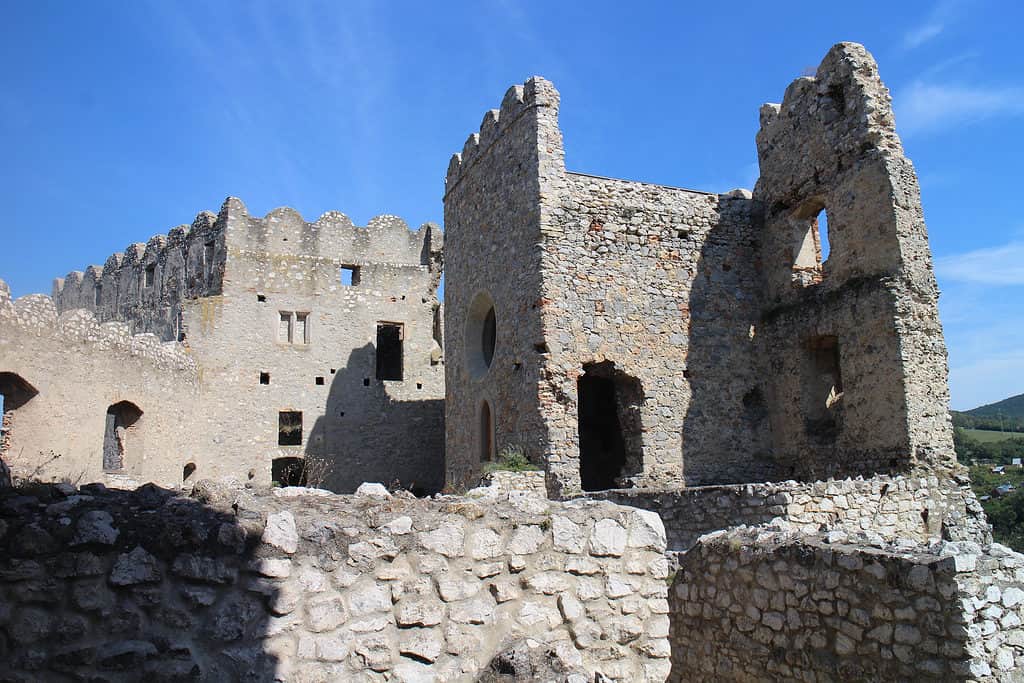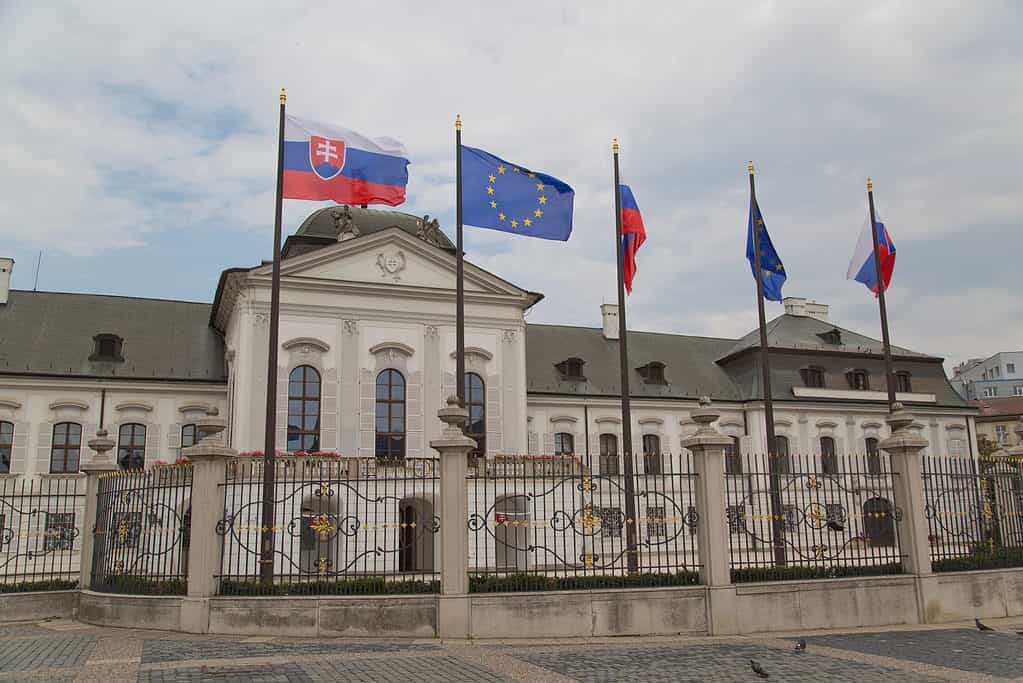Slovakia is a unique and beautiful country. This landlocked Central European country has stunning architecture and buildings, including the world’s highest wooden altar. There are also plenty of castles to explore in the beautiful country.
Aside from the beauty the country offers, its flag is vibrant and eye-catching. There is a lot of history and meaning behind Slovakia’s flag. Are you ready to learn more? Continue reading to discover the history, meaning, and symbolism behind the flag of Slovakia.

Slovakia is a unique and beautiful country. This landlocked Central European country has stunning architecture and buildings, including the world’s highest wooden altar.
©hyotographics/Shutterstock.com
Where is Slovakia?
Slovakia is a small landlocked country in Central Europe containing beautiful mountains, caves, and dense forests. Five countries, Poland to the north, Austria to the southeast, Ukraine to the east, Hungary to the south, and the Czech Republic to the northwest border Slovakia. Slovakia has a surface area of 19,000 square miles and is home to over 5.4 million people.
The History of Slovakia
Slovakia’s history is long and rich. We are only going to delve into a brief summary to better understand the flag and its meaning. The first ancient habitation of Slovakia goes back to approximately 270,000 BCE. Scientists have found old surviving artifacts from the Early Paleolithic era near Nové Mesto nad Váhom. For example, experts found the Venus of Moravany, a mammoth bone statue, in the country.
For centuries, before Slovakia gained its independence, it was part of the Kingdom of Poland and the Kingdom of Hungary. It shares a similar culture and traditions with Poland and Hungary because of their proximity and shared history. Slovakia was also part of the independent republic of Czechoslovakia from 1918 to 1983. This republic included Bohemia, Moravia, Subcarpathian Ruthenia, Slovakia, and a small part of Silesia.
Slovakia fully gains its independence in 1992 after an election and Václav Klaus’s Civic Democratic Party won. Mečiar and Klaus negotiated and started the dissolution of Czechoslovakia. Michal Kováč became the first president of newly independent Slovakia. Since then Slovakia has joined the EU and NATO.

The first ancient habitation of Slovakia is thought to be dated at 270,000 BCE.
©P.Fabian/Shutterstock.com
What Does the Flag of Slovakia Look Like?
The flag of Slovakia is a horizontal tricolor flag. It is red, white, and blue. From top to bottom, the order is white, blue, and red. However, the coat of arms of the flag does not follow this order. The coat of arms is off-center on the flag and has a red shield, with an enlarged double cross. There are also three blue hills at the bottom of the shield.
History of the Flag of Slovakia
The flag of Slovakia was adopted on September 3, 1992. It’s made up of Pan-Slavic colors, which are red, white, and blue. Many of the flags used previously are similar in appearance, using the same colors. The first time the current flag of Slovakia was used was about 1848. It was also used unofficially by Czechoslovakia before World War II and by the Slovak Republic during World War II.
Since the flag of Slovakia looks very similar to the flag of the Russian Federation and the flag of Slovenia, the interior ministry tasked Ladislav Čisárik to create a new coat of arms for the national flag. He based it on the 14th-century coat of arms but changed it slightly so it had a national symbol to stand apart from other flags. The coat of arms was created after the flag.

The flag of Slovakia was adopted on September 3, 1992. It’s made up of Pan-Slavic colors, which are red, white, and blue.
©Kutikan/Shutterstock.com
Meaning and Symbolism of Slovakia’s Flag
The design of the Slovakia flag is with great meaning. Everything designed on Slovakia’s flag is intentional. For example, the three colors (blue, red, and white) are found on almost all the flags of Slavic nations. The three colors indicate Slavic unity and independence. The three blue mountains in the shield symbolize three important mountain ranges in the country: Tatra, Matra, and Fatra. The mountain of three peaks is on previous flags. This meaning traces back to the 15th and 16th centuries. Interestingly, the mountains were originally green, but the color changed in 1848 when the Slovak National Council decided the flag and the coat of arms needed to use the Slavic tricolors.
Last but not least, on the flag is a white double cross. The white double cross symbolizes Slovakia as a guardian of Christian tradition. However, we do not know the exact meaning since other mostly Christian nations use the typical Christian cross. The double cross though originates from the Byzantine Empire (Eastern Rome). One interpretation is that the first horizontal line symbolizes secular power, while the second line refers to the ecclesiastic power of Byzantine emperors.
However, the first line is sometimes also interpreted as the death and the second cross the resurrection of Jesus Christ. The double cross is not a new symbol. It was also in use in the Kingdom of Hungary. The double cross is on coins and a coat of arms.
Up Next:
- The Flag of Lesotho: History, Meaning, and Symbolism
- Countries With Striped Flags
- The Flag of Cote d’Ivoire: History, Meaning, and Symbolism
- The Flag of Equatorial Guinea: History, Meaning, and Symbolism
The photo featured at the top of this post is © Tatohra/Shutterstock.com
Thank you for reading! Have some feedback for us? Contact the AZ Animals editorial team.






